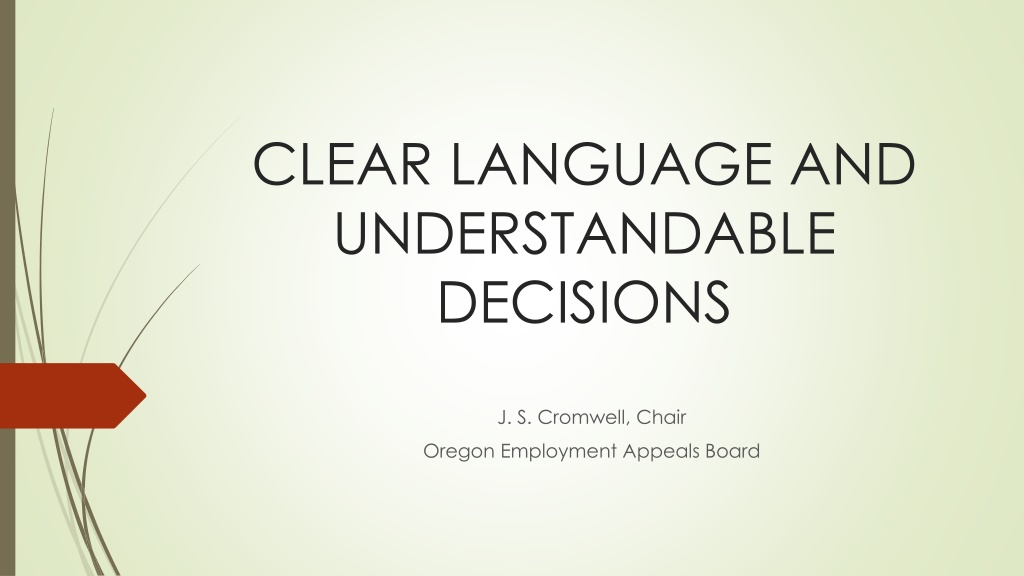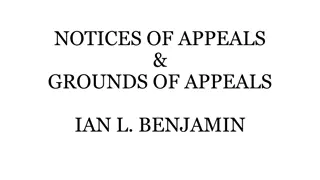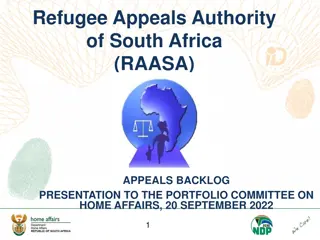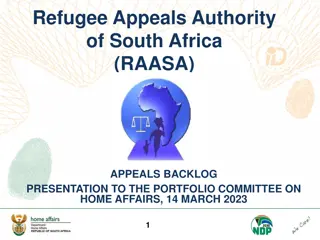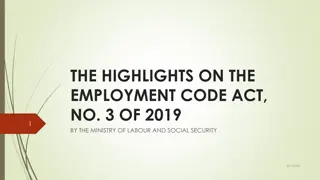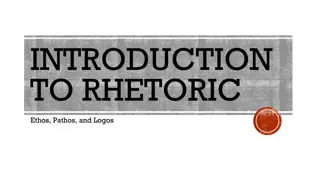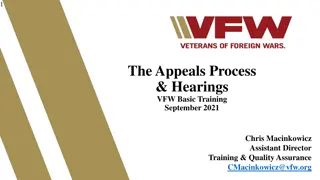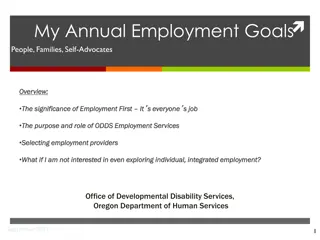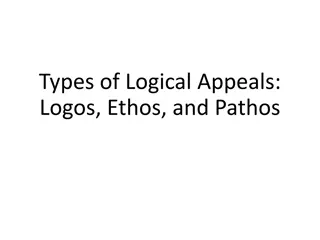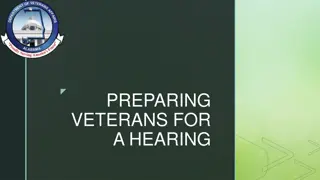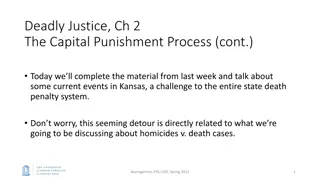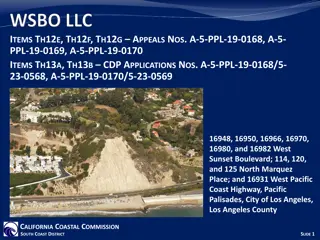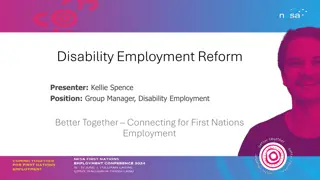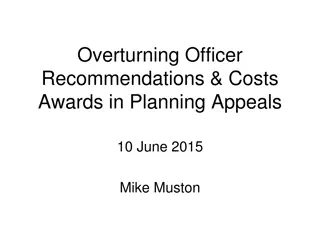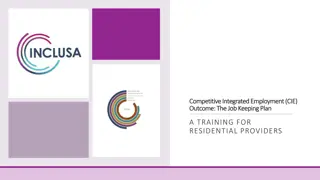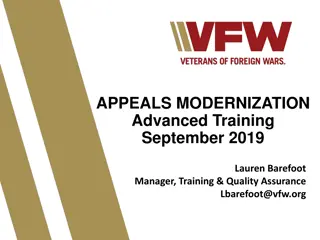Clear Language and Understandable Decisions in Employment Appeals
This content emphasizes the importance of clear and understandable decision-making in the context of employment appeals, particularly considering the large number of adults in the U.S. who struggle with literacy. It highlights the significance of writing decisions ethically and with the audience's understanding in mind, aiming to inform parties involved in benefit determinations accurately and fairly. The purpose is to enhance readability, comprehension, and acceptance of decisions.
Download Presentation

Please find below an Image/Link to download the presentation.
The content on the website is provided AS IS for your information and personal use only. It may not be sold, licensed, or shared on other websites without obtaining consent from the author. Download presentation by click this link. If you encounter any issues during the download, it is possible that the publisher has removed the file from their server.
E N D
Presentation Transcript
CLEAR LANGUAGE AND UNDERSTANDABLE DECISIONS J. S. Cromwell, Chair Oregon Employment Appeals Board
Who is in our audience? 36 million adults in the United States struggle to read at a third-grade level. OECD, Time for the US to Reskill?: What the Survey of Adult Skills Says, OECD Skills Studies, OECD Publishing, 2013. Another 63 million adults in the United States can perform only basic literacy activities. Council for Advancement of Adult Literacy, Report of the National Commission on Adult Literacy, 2008, citing NCES, National Assessment of Adult Literacy, NAAL 2003, U.S. Department of Education 2005. 37% of twelfth-grade students can read at grade-appropriate levels, and when analyzed by race the percentages of proficient twelfth-graders plummeted among some populations; proficiency levels were also significantly reduced among individuals for whom English is a second language, whose parents struggled with literacy, and who have been to prison. NCES, The Nation s Report Card: 2015 Mathematics and Reading at Grade 12, NCES Online Report, 2016.
What does that mean . . . . . . to parties ability to read our decisions? . . . to parties ability to understand our decisions? . . . to parties ability to understand what will happen because of our decisions? . . . to parties ability to accept that our decisions are correct and fair and reached for the right reasons?
Clear Decision Writing is Ethical Decision Writing
The Golden Rule of Decision Writing Write for others as you would have them write for you. - Style: Lessons in Clarity and Grace, 12thed. J. Williams and J. Bizup (2017).
We write ethically when, as a matter of principle, we would trade places with our intended readers and experience the consequences they do after they read our writing. The burden is on the writer, not the reader. Readers time is valuable, and they do not owe us an indefinite amount of their time to unpack our writing. - Style: Lessons in Clarity and Grace, 12thed. J. Williams and J. Bizup (2017).
What is the purpose of our writing? Notifying parties of benefits determinations Explaining what the law is and how it applies Explaining why claimants do or do not get benefits, or why employers are or are not charged Informing state workforce agencies about the parties benefit entitlement and chargeability Explaining why we disagree with prior decisions Issuing legally and factually correct decisions that will withstand higher authority or judicial scrutiny
Whatever our reasons for writing, we should strive to hold proceedings and issue decisions that the parties can understand and accept as correct, fair, and well-reasoned.
What makes a decision correct, fair, and well-reasoned? A sufficiently developed record Substantial evidence A decision lacks substantial evidence if the credible evidence apparently weighs overwhelmingly in favor of one finding and the Board finds the other without giving persuasive explanation. Armstrong v Asten-Hill Co., 90 Or App 200, 206 (1988). All facts found must be supported by substantial evidence. Substantial reason Substantial reason requires a factual anchor. If there is no fact directly tied to the analysis, substantial reason fails.
How might an insufficiently developed record or the absence of substantial evidence and reason show up in a decision? Vague phrasing Sentences lacking a clear subject, verb, and/or object Inferences that are not supported by or tied to record evidence Impermissibly filling in the blanks with our own experiences or perceptions or unexplained assumptions Characterizing emotions and feelings or exaggerating them with superlatives Speculating Acknowledging only evidence that supports the ultimate conclusion without acknowledging evidence that might suggest a different outcome Burden creep
How else might they show up? Reversals & Remands Nickerson v. Employment Dept., 250 Or. App. 352, 358, 280 P.3d 1014 (2012) The EAB may be entitled to draw reasonable inferences from facts in evidence, but it is not entitled to conjure findings from thin air. Kay v. Employment Dept., 292 Or. App 700, 425 P.3d 502 (2018) Because the EAB s finding that the owner s frustration about claimant not returning his messages was the impetus for his January 24 text messages is not supported by substantial evidence, but rather appears to be mere speculation, the reasoning in EAB s decision necessarily fails.
Components of an ethically written decision Be specific Be correct Be professional Write accessibly Clearly identify the actors and their actions Identify your inferences when you make them, and then clearly tie the inferences back to evidence in the record Make sure your legal conclusions are supported by the record Be fair: establish that you considered all the evidence by explaining why the facts that do not support your conclusion were not persuasive Make sure the losing party s perspective shows up in your final written product
If our goal is to issue decisions that the parties can understand, what are some barriers we might encounter? Legalese Big words when diminutive ones would suffice Long sentences with complex grammar structures Long paragraphs containing multiple ideas A disordered analysis TMI Citations Language barriers Etc.
Writing Solutions Identify your audiences. Evaluate their levels of understanding. Use shorter words, sentences, and paragraphs. Practice: Take a writing class or judicial writing class Read a style and grammar refresher Re-edit some of your work from 6 months ago and see what changes you could have made to improve the understandability of your decision Take the Up-Goer Five Challenge
The Up-Goer Five Challenge The Employment Appeals Board reviews orders resulting from contested unemployment insurance hearings. In most cases EAB issues a decision affirming, modifying, or reversing the underlying order, but in some cases EAB reverses and remands the case to the Office of Administrative Hearings with instructions to gather additional evidence. We look at stuff other people already looked at and decided and wrote about, and then we look at and decide and write about the same stuff all over again. Sometimes we agree with the other people and sometimes we do not, and sometimes we make the other people have a do-over.
The Up-Goer Five Challenge, cont. Claimant was overpaid $500 as a matter of law, and is liable to repay the overpayment to the Employment Department or have the debt deducted from future benefits otherwise payable. You owe $500.
Writing Solutions, cont. Write in a logical order Grammar rules, shmammar rules Tell a story Remove irrelevant portions of the law Use writing techniques to make your readers smarter as they work their way through your decision One idea per paragraph No surprises! Chain your sentences together, beginning each with old information, introduce new information, the new information then becomes old, and you use that old information to introduce more new information Smart readers are informed readers; consider what other techniques you can use to make your readers smarter as they make their ways through your decisions
If our goal is to issue decisions that the parties can accept, what barriers to acceptance might we encounter? Didn t feel heard Didn t feel understood Didn t understand the process Having to read many pages into a decision before they find out if the decision was in their favor Reading through the entire administrative, hearing, and appeals decisions and still not having any idea why they lost
In other words . . . How can anyone be expected to accept a decision as correct, fair, and well-reasoned if they cannot understand what the decision says, what it means, or how it will affect them?
Writing Solutions Before you write: Identify your audiences and think about what they will want and need to know. Use that information to frame your thoughts. Ask yourself why the party requested a hearing or appealed to the higher authority appeals office in the first place, and focus on that. While you write: Write as simply and clearly as possible make your decision as accessible as possible. Put aside what YOU want to say or how you want to say it, and focus on your reader what does the reader NEED to know, and how will THEY best understand. Make sure the parties feel heard, especially if the decision s outcome is adverse to them. Use the losing party s language when finding against them. If a party feels like we heard them and understood their points and arguments, our processes and decisions are more likely to be perceived as legitimate. After you write: Edit carefully for clerical, factual, and logic errors. Ask your peers to help you. A professional-looking decision will go a long way toward legitimizing the hearing process and the decision you have issued.
Some Final Thoughts: Write objectively we don t make the decision, the law compels the decision to be made. Don t give parties false hope that they can change your mind about the outcome by using wishy-washy phrasing in your decisions. Remember that identifying what persuaded you to reach a conclusion is no replacement for an actual analysis. Dye v. Employment Dept., 203 Or. App. 39, 125 P.3d 775, 778 (2005), citing Portland Assn. Teachers v. Mult. Sch. Dist. No. 1, 171 Or.App. 616, 644, 16 P.3d 1189 (2000). Parties and reviewing bodies cannot tell what the basis of a decision is if we simply identify what was persuasive without explaining why it was persuasive, and why other evidence that might have compelled a different conclusion was not. Consider, have you used your decision as an opportunity to educate the parties about the basis of the decision, what effect it will have on them, and any next steps they need to take? If not, take another look. Seek out feedback about your work and listen to it. Peers, supervisors, customer service surveys, post-decision letters from parties, higher authority, or judicial reversals and remands are all invaluable tools that can help you identify your writing challenges and overcome them.
Questions? J. S. Cromwell, Chair Oregon Employment Appeals Board Sara.D.Cromwell@Oregon.gov Edward S. Steinmetz, Assistant Chief Administrative Law Judge Washington State Office of Administrative Hearings Edward.Steinmetz@oah.wa.gov Thank you for attending!
